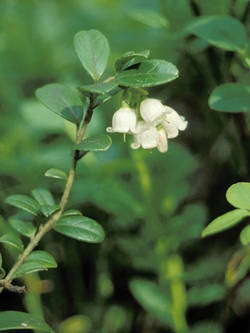
Perhaps everyone knows this evergreen shrub from the Lingonberry family (according to the older classification - Vereskovyh). This widespread plant is found throughout the forest zone of Russia, in the forest-tundra, tundra, and reaches the shores of the Arctic Ocean. It grows in coniferous, mainly pine and mixed lowland and mountain forests, and in the Far East even in thickets of rhododendron. In the Caucasus, it rises in the mountains to an altitude of 3300 m. Now they are trying to grow it in culture.
The leaves of the lingonberry are overwintering, leathery, dense, short-petiolate, dark green above, shiny, paler and dull below, slightly curled along the edge, with light pinpoint glands. And it is they who are the most important medicinal raw material, but the harvesting of the tops of the shoots is also quite acceptable. But the biggest trick is when to gather raw materials. The harvesting of leaves and shoots is carried out either immediately after the snow has melted and stopped before the flowering of lingonberries, or in the fall after the berries ripen. Summer leaves turn black when dried, and the raw material loses its presentation. So they must be either "survived" the winter or have already withstood the autumn frosts. Raw materials are dried in attics with good ventilation or under a canopy, spreading out in a loose layer and stirring occasionally.
The plant blooms in May and during this period it looks touching and tender. The flowers are white, bell-shaped, collected in short apical brushes.
And from the middle of August, the fruits ripen - polyspermous bright red berries up to 8 mm in diameter. The fruits are used fresh or for the preparation of gastronomic delights, for example, soaked lingonberries - the most delicious side dish for meat and chicken.
 |  |
Medicinal and useful properties
But back to medicinal properties. Lingonberry leaves contain arbutin, methylarbutin, phenolcarboxylic acids, catechins, tannins, flavonoids, vitamin C. These substances with abstruse names give the lingonberry leaf all its pharmacological properties.
Fruits contain sugars (fructose, glucose, sucrose, pectin), organic acids, vitamins (C, PP), essential oil, anthocyanins. Thanks to the presence of preservative benzoic acid, soaked lingonberries keep so well.
Lingonberry preparations significantly increase urinary excretion, have antiseptic and salt-dissolving properties, which is very important for nephrolithiasis and gout. The therapeutic effect of lingonberry is mainly due to the phenolic compound arbutin, which in an alkaline environment cleaves off hydroquinone, which has a strong antiseptic effect. Normally, urine is acidic, so taking lingonberry preparations should be accompanied by the use of alkaline mineral waters or baking soda.
In scientific medicine, decoction and infusion of leaves are used as a diuretic for diseases of the kidneys and bladder (pyelitis, cystitis, pyelonephritis, urinary and kidney stones), as well as for acute and chronic inflammatory processes in the genitourinary system, nocturnal urinary incontinence, mild forms of sugar diabetes. Lingonberry leaves are a substitute for bearberry, which can also be found at the pharmacy. In folk medicine, a decoction of the leaves and fruits of lingonberry mixed with the herb St. John's wort is used for enuresis (urinary incontinence). In a mixture with other plants, lingonberry leaves are used for prostate adenoma, as well as for acute and chronic prostatitis. Black, overwintered leaves are a good substitute for tea.
Fresh fruits are considered a tonic, thirst quencher and tonic. According to some reports, lingonberry fruit is an excellent aphrodisiac remedy for older men.They are used in folk medicine as a diuretic (though less powerful than leaves) and vitamin remedy.
Lingonberry berries in the form of juice, jam, jelly, compote reduce the content of radioactive cesium in the body by 1.5-3 times, and at the same time improve the functioning of the immune system. The inclusion of berries in the diet reduces inflammation in the gastrointestinal tract and urinary tract, strengthens the walls of blood vessels, and prevents mastitis in nursing mothers.
Lingonberry berries are widely used for food in raw and processed form, for the manufacture of juices, fruit drinks, kvass, wines, tinctures, liqueurs.
 |  |
Recipes for use
Now a few tips on how to apply it.
Decoction of leaves prepared from 2 tablespoons of crushed raw materials, which is poured with 1 glass of boiling water, heated in a water bath for 30 minutes, infused until cooled, filtered, and then taken 1 / 3-1 / 2 cup 2-3 times a day.
Infusion of leaves. Take 3-4 teaspoons of crushed raw materials, pour 1 glass of boiling water, heat in a water bath for 15 minutes, insist until cooled, drain. Take 1/4 cup 3-4 times daily before meals.
Lingonberry tea prepared as follows: pour 1 teaspoon of chopped leaves with 1 cup of boiling water, leave for 30 minutes, drain. Take 1 / 4-1 / 2 cup 3 times daily before meals. It is especially recommended to drink this tea in case of kidney and bladder diseases for patients with anacid gastritis, as well as those suffering from gout.
Infusion of leaves and fruits... 1 tablespoon of a mixture of leaves, lingonberry and St. John's wort (in a ratio of 1: 1: 1) pour 1 cup boiling water, simmer for 10 minutes, leave for 1 hour, drain. Take 1/2 cup 5 times a day, starting at 4 o'clock, with bedwetting.
Tincture of leaves in folk medicine used for cholecystitis. Pour 50 g of fresh lingonberry leaves with 0.5 liters of vodka and leave in a dark place for 2 weeks. Strain and take 15-20 drops in a spoonful of water 30 minutes before meals. The course of treatment is 3-4 weeks.









